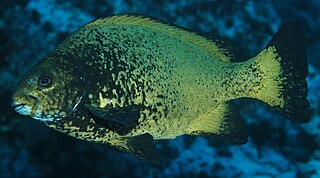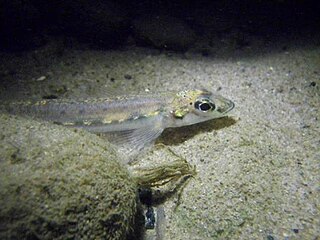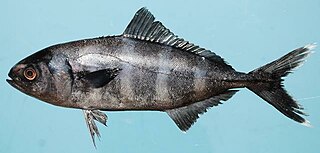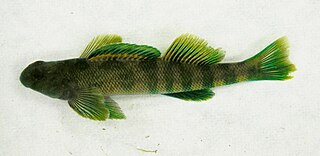
The Percidae are a family of ray-finned fish, part of the order Perciformes, which are found in fresh and brackish waters of the Northern Hemisphere. The majority are Nearctic, but there are also Palearctic species. The family contains more than 200 species in 11 genera. The perches, and their relatives are in this family; well-known species include the walleye, sauger, ruffe, and three species of perch. However, small fish known as darters are also a part of this family.

Sander is a genus of predatory ray-finned fish in the family Percidae, which also includes the perches, ruffes, and darters. They are also known as "pike-perch" because of their resemblance to fish in the unrelated Esocidae (pike) family. They are the only genus in the monotypic tribe Luciopercini, which is one of two tribes in the subfamily Luciopercinae,

Romanichthys is a genus of ray-finned fish, one of two genera in the tribe Romanichthyini, which along with the tribe Luciopercini, forms the subfamily Luciopercinae of the family Percidae, alongside the perches, ruffes, and darters. The genus contains the single species Romanichthys valsanicola, known as the sculpin-perch, asprete, or Romanian darter.

The sea chubs are a family, Kyphosidae, of fishes in the order Perciformes native to the Atlantic, Indian and Pacific Oceans usually close to shore in marine waters.

Pentacerotidae or armourheads are a small family of fishes in the order Perciformes. They are native to the Indian Ocean, western and central Pacific, and southwestern Atlantic. They are generally found at rocky reefs below normal scuba diving depths, although several species occur in low densities at shallower depths.

Ammocrypta is a genus of freshwater ray-finned fish, commonly known as the sand darters, which is classified in the subfamily Etheostomatinae, part of the family Percidae which also includes the perches, ruffes and pikeperches. The species in the genus occur in eastern North America in Canada and the continental United States.

Caranginae is a subfamily of ray-finned fish from the family Carangidae which consists of twenty genera and 103 species.

Crystallaria is a genus of freshwater ray-finned fish which is classified in the subfamily Etheostomatinae, commonly known as the darters, part of the family Percidae which also includes the perches, ruffes and pikeperches. They are found in the Mississippi River basin from Ohio to Minnesota and in southern Mississippi, northern Louisiana, and southeastern Oklahoma, and on the Gulf Slope of Escambia, Mobile Bay, and the Pearl River drainages. They have now been extirpated from Ohio, Kentucky, Indiana, and Illinois.

Gymnocephalus is a genus of ray-finned fishes from the family Percidae, which includes the perches, pike-perches and darters. They are from the Western Palearctic area, although one species, Gymnocephalus cernua has been accidentally introduced to the Great Lakes region where it is regarded as an invasive species. They have the common name "ruffe" and resemble the true perches in the genus Perca, but are usually smaller and have a different pattern.

Percarina is a genus of ray-finned fish in the family Percidae they are found in eastern Europe. The genus is the only taxon in the monotypic subfamily Percarininae which is characterised by having the first dorsal fin having 9-11 spines and being widely separated from the second dorsal fin. They are thought to be closely related both to the perches of the genus Perca and to the ruffes of the genus Gymnocephalus.

Sander volgensis, the Volga pikeperch or Volga zander, is a species of fish in the perch family Percidae. It is found in Austria, Azerbaijan, Bosnia and Herzegovina, Bulgaria, Croatia, Hungary, Moldova, Romania, Russia, Serbia, Slovakia, and Ukraine.

Zingel is a genus of fish in the family Percidae. They are long and slender, reaching 12 to 48 cm in length. They are found in rivers and streams in Europe. They feed mainly on aquatic invertebrates such as crustaceans and insect larvae, and also eat small fish. While they were all classed as endangered or vulnerable in the past, environmental improvements have allowed some to be reclassified to least concern.

Tincinae is a subfamily of freshwater ray-finned fish from the family Cyprinidae, it consists of the tench of Eurasia and the east Asian clod minnows.

Zingel zingel, the zingel, is a species of freshwater ray-finned fish in the family Percidae. It is found in fast-flowing streams in southeastern Europe. It is the type species of the genus Zingel.

The Procatopodini is an African tribe of fishes, it is part of the subfamily Procatopodinae, within the family Poeciliidae.

Scomberoidinae is a subfamily of ray-finned fish from the family Carangidae which consists of three genera and 10 species. The species in this subfamily have been given the common names leatherjacket and queenfish.

Naucratinae is a subfamily of ray-finned fish from the family Carangidae which consists of five genera and 13 species.

Centrarchinae is a subfamily of freshwater ray-finned fish, one of three subfamilies in the family Centrarchidae, the sunfishes.

The Luciopercinae is a subfamily of ray-finned fish, classified within the family Percidae, the subfamily includes the pike-perches and zingels. The pike-perches of the genus Sander have an Holarctic distribution while the zingels of the tribe Romanichthyini are found in Europe. They are largely freshwater species but some can be found in brackish water.

Etheosomatidae is a species rich subfamily of freshwater ray-finned fish, the members of which are commonly known as the darters. The subfamily is part of the family Percidae which also includes the perches, ruffes and pikeperches. The family is endemic to North America. It consists of 3-5 different genera and well over 200 species.




















